Investigating Workplace Transformation Needs: The Case of Tesco
VerifiedAdded on 2023/06/12
|21
|5518
|99
Report
AI Summary
This report examines the imperative of workplace transformation, focusing on Tesco as a case study. It delves into the project lifecycle, encompassing initiation, planning, execution, monitoring, and closure, while emphasizing the importance of each stage. A project management plan is outlined, highlighting the significance of time, quality, communication, risk, and resource management. The research methodology incorporates both quantitative (questionnaires) and qualitative (literature review) approaches to gather comprehensive data. Findings from the research are presented, followed by strategic recommendations for Tesco. The report concludes with a reflective practice section, summarizing the key insights and lessons learned from the project, underscoring the necessity for organizations to adapt to the dynamic business environment through effective workplace transformation strategies. Desklib provides access to similar solved assignments and study tools for students.
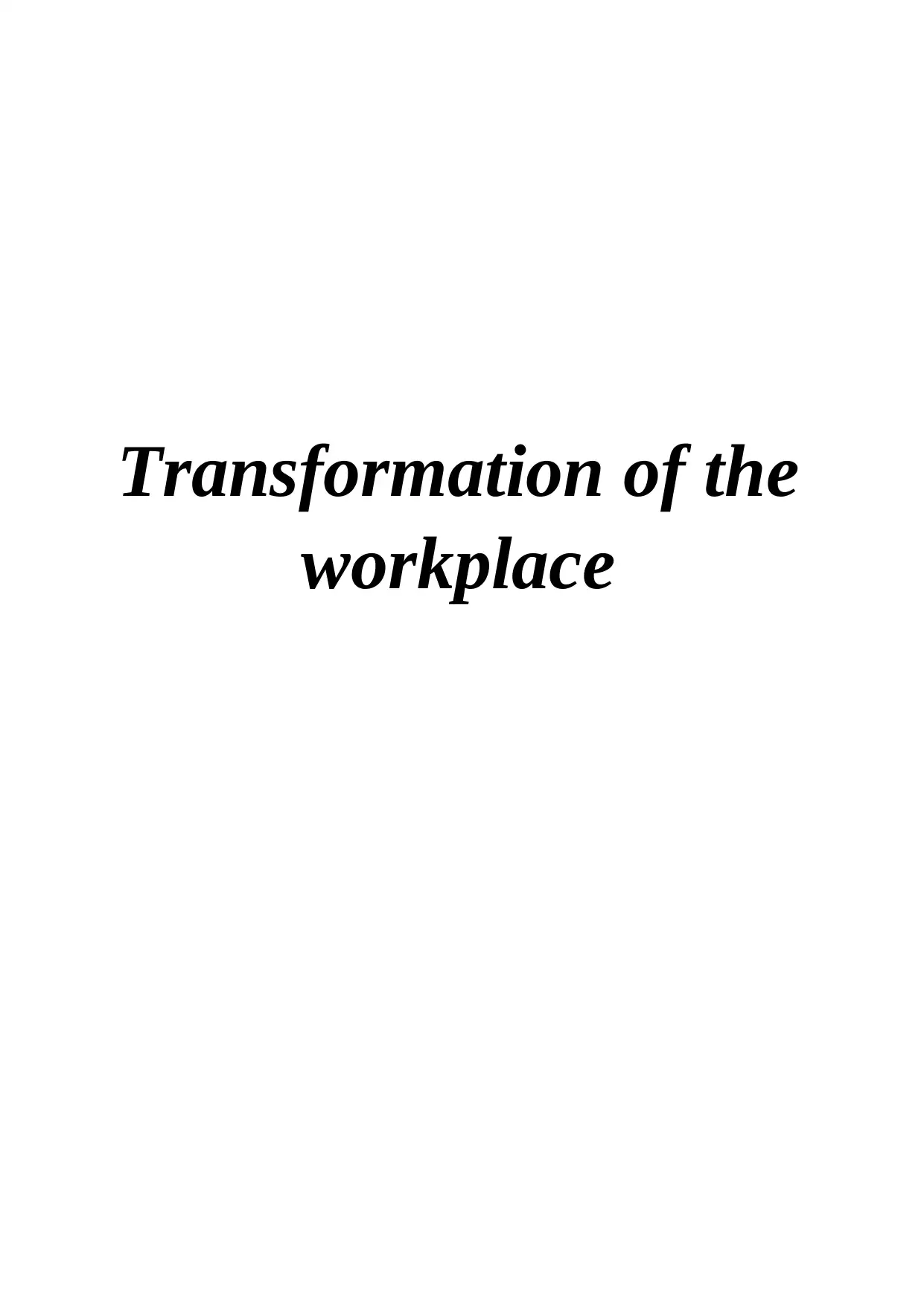
Transformation of the
workplace
workplace
Paraphrase This Document
Need a fresh take? Get an instant paraphrase of this document with our AI Paraphraser
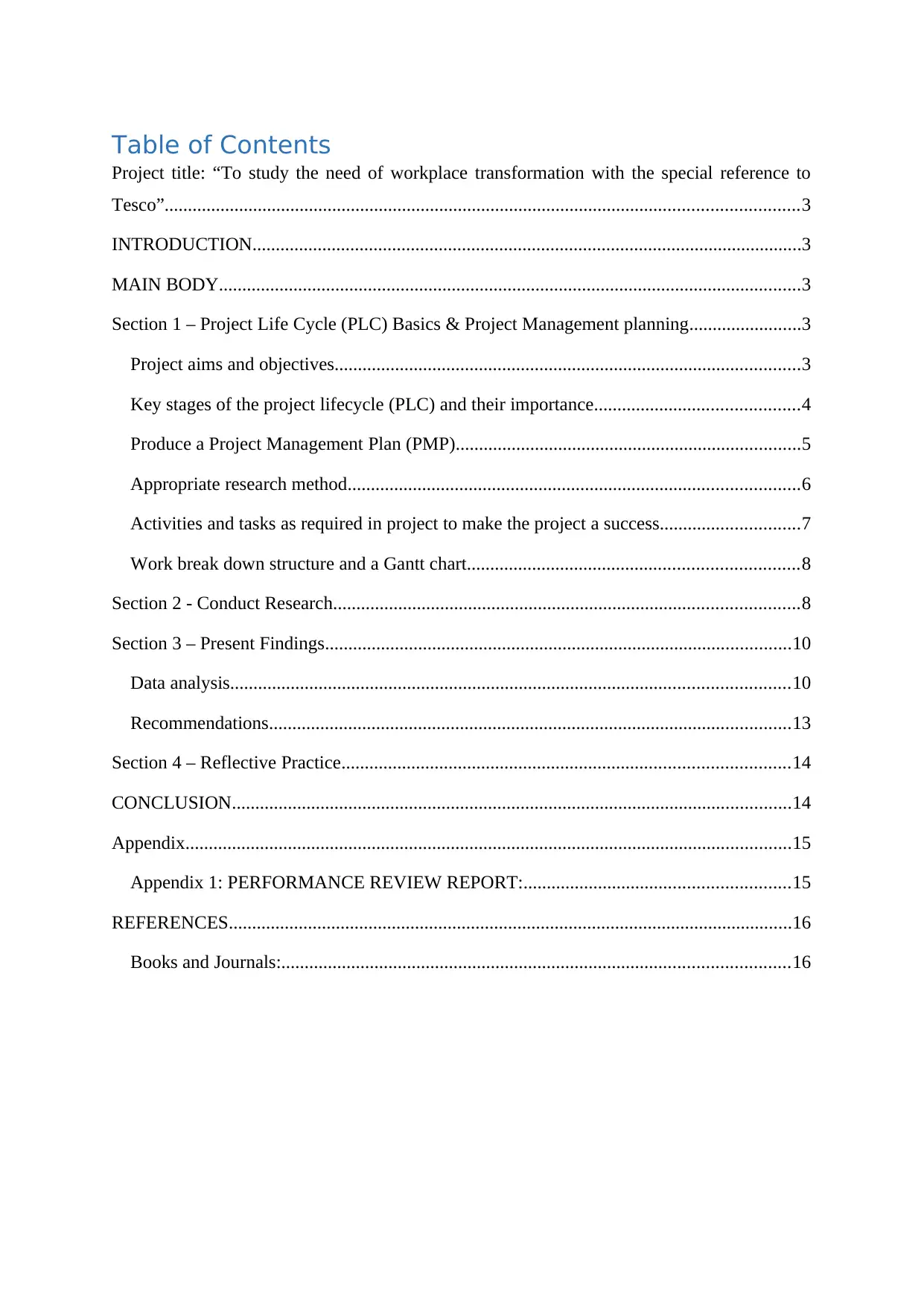
Table of Contents
Project title: “To study the need of workplace transformation with the special reference to
Tesco”........................................................................................................................................3
INTRODUCTION......................................................................................................................3
MAIN BODY.............................................................................................................................3
Section 1 – Project Life Cycle (PLC) Basics & Project Management planning........................3
Project aims and objectives....................................................................................................3
Key stages of the project lifecycle (PLC) and their importance............................................4
Produce a Project Management Plan (PMP)..........................................................................5
Appropriate research method.................................................................................................6
Activities and tasks as required in project to make the project a success..............................7
Work break down structure and a Gantt chart.......................................................................8
Section 2 - Conduct Research....................................................................................................8
Section 3 – Present Findings....................................................................................................10
Data analysis........................................................................................................................10
Recommendations................................................................................................................13
Section 4 – Reflective Practice................................................................................................14
CONCLUSION........................................................................................................................14
Appendix..................................................................................................................................15
Appendix 1: PERFORMANCE REVIEW REPORT:.........................................................15
REFERENCES.........................................................................................................................16
Books and Journals:.............................................................................................................16
Project title: “To study the need of workplace transformation with the special reference to
Tesco”........................................................................................................................................3
INTRODUCTION......................................................................................................................3
MAIN BODY.............................................................................................................................3
Section 1 – Project Life Cycle (PLC) Basics & Project Management planning........................3
Project aims and objectives....................................................................................................3
Key stages of the project lifecycle (PLC) and their importance............................................4
Produce a Project Management Plan (PMP)..........................................................................5
Appropriate research method.................................................................................................6
Activities and tasks as required in project to make the project a success..............................7
Work break down structure and a Gantt chart.......................................................................8
Section 2 - Conduct Research....................................................................................................8
Section 3 – Present Findings....................................................................................................10
Data analysis........................................................................................................................10
Recommendations................................................................................................................13
Section 4 – Reflective Practice................................................................................................14
CONCLUSION........................................................................................................................14
Appendix..................................................................................................................................15
Appendix 1: PERFORMANCE REVIEW REPORT:.........................................................15
REFERENCES.........................................................................................................................16
Books and Journals:.............................................................................................................16
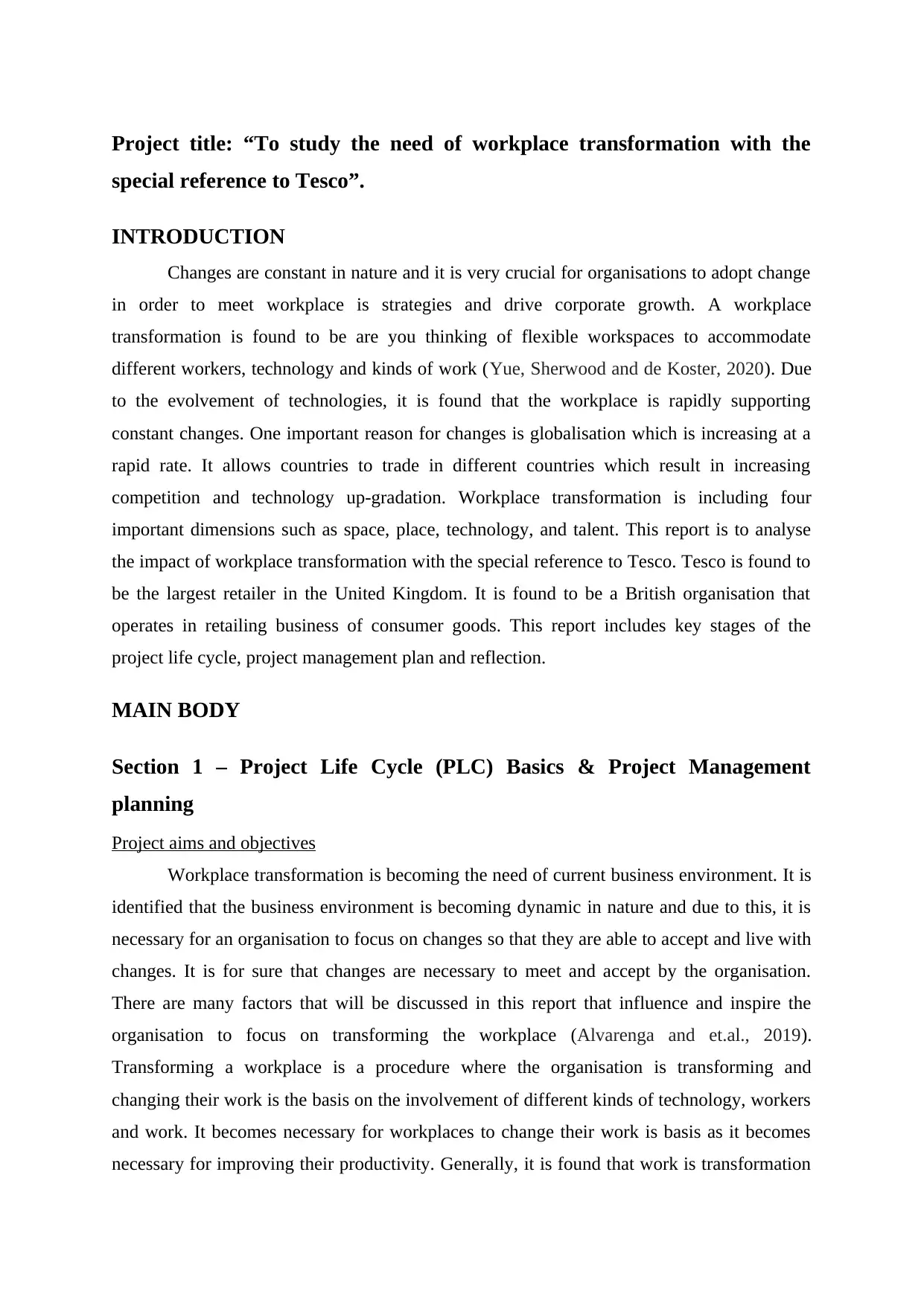
Project title: “To study the need of workplace transformation with the
special reference to Tesco”.
INTRODUCTION
Changes are constant in nature and it is very crucial for organisations to adopt change
in order to meet workplace is strategies and drive corporate growth. A workplace
transformation is found to be are you thinking of flexible workspaces to accommodate
different workers, technology and kinds of work (Yue, Sherwood and de Koster, 2020). Due
to the evolvement of technologies, it is found that the workplace is rapidly supporting
constant changes. One important reason for changes is globalisation which is increasing at a
rapid rate. It allows countries to trade in different countries which result in increasing
competition and technology up-gradation. Workplace transformation is including four
important dimensions such as space, place, technology, and talent. This report is to analyse
the impact of workplace transformation with the special reference to Tesco. Tesco is found to
be the largest retailer in the United Kingdom. It is found to be a British organisation that
operates in retailing business of consumer goods. This report includes key stages of the
project life cycle, project management plan and reflection.
MAIN BODY
Section 1 – Project Life Cycle (PLC) Basics & Project Management
planning
Project aims and objectives
Workplace transformation is becoming the need of current business environment. It is
identified that the business environment is becoming dynamic in nature and due to this, it is
necessary for an organisation to focus on changes so that they are able to accept and live with
changes. It is for sure that changes are necessary to meet and accept by the organisation.
There are many factors that will be discussed in this report that influence and inspire the
organisation to focus on transforming the workplace (Alvarenga and et.al., 2019).
Transforming a workplace is a procedure where the organisation is transforming and
changing their work is the basis on the involvement of different kinds of technology, workers
and work. It becomes necessary for workplaces to change their work is basis as it becomes
necessary for improving their productivity. Generally, it is found that work is transformation
special reference to Tesco”.
INTRODUCTION
Changes are constant in nature and it is very crucial for organisations to adopt change
in order to meet workplace is strategies and drive corporate growth. A workplace
transformation is found to be are you thinking of flexible workspaces to accommodate
different workers, technology and kinds of work (Yue, Sherwood and de Koster, 2020). Due
to the evolvement of technologies, it is found that the workplace is rapidly supporting
constant changes. One important reason for changes is globalisation which is increasing at a
rapid rate. It allows countries to trade in different countries which result in increasing
competition and technology up-gradation. Workplace transformation is including four
important dimensions such as space, place, technology, and talent. This report is to analyse
the impact of workplace transformation with the special reference to Tesco. Tesco is found to
be the largest retailer in the United Kingdom. It is found to be a British organisation that
operates in retailing business of consumer goods. This report includes key stages of the
project life cycle, project management plan and reflection.
MAIN BODY
Section 1 – Project Life Cycle (PLC) Basics & Project Management
planning
Project aims and objectives
Workplace transformation is becoming the need of current business environment. It is
identified that the business environment is becoming dynamic in nature and due to this, it is
necessary for an organisation to focus on changes so that they are able to accept and live with
changes. It is for sure that changes are necessary to meet and accept by the organisation.
There are many factors that will be discussed in this report that influence and inspire the
organisation to focus on transforming the workplace (Alvarenga and et.al., 2019).
Transforming a workplace is a procedure where the organisation is transforming and
changing their work is the basis on the involvement of different kinds of technology, workers
and work. It becomes necessary for workplaces to change their work is basis as it becomes
necessary for improving their productivity. Generally, it is found that work is transformation
⊘ This is a preview!⊘
Do you want full access?
Subscribe today to unlock all pages.

Trusted by 1+ million students worldwide
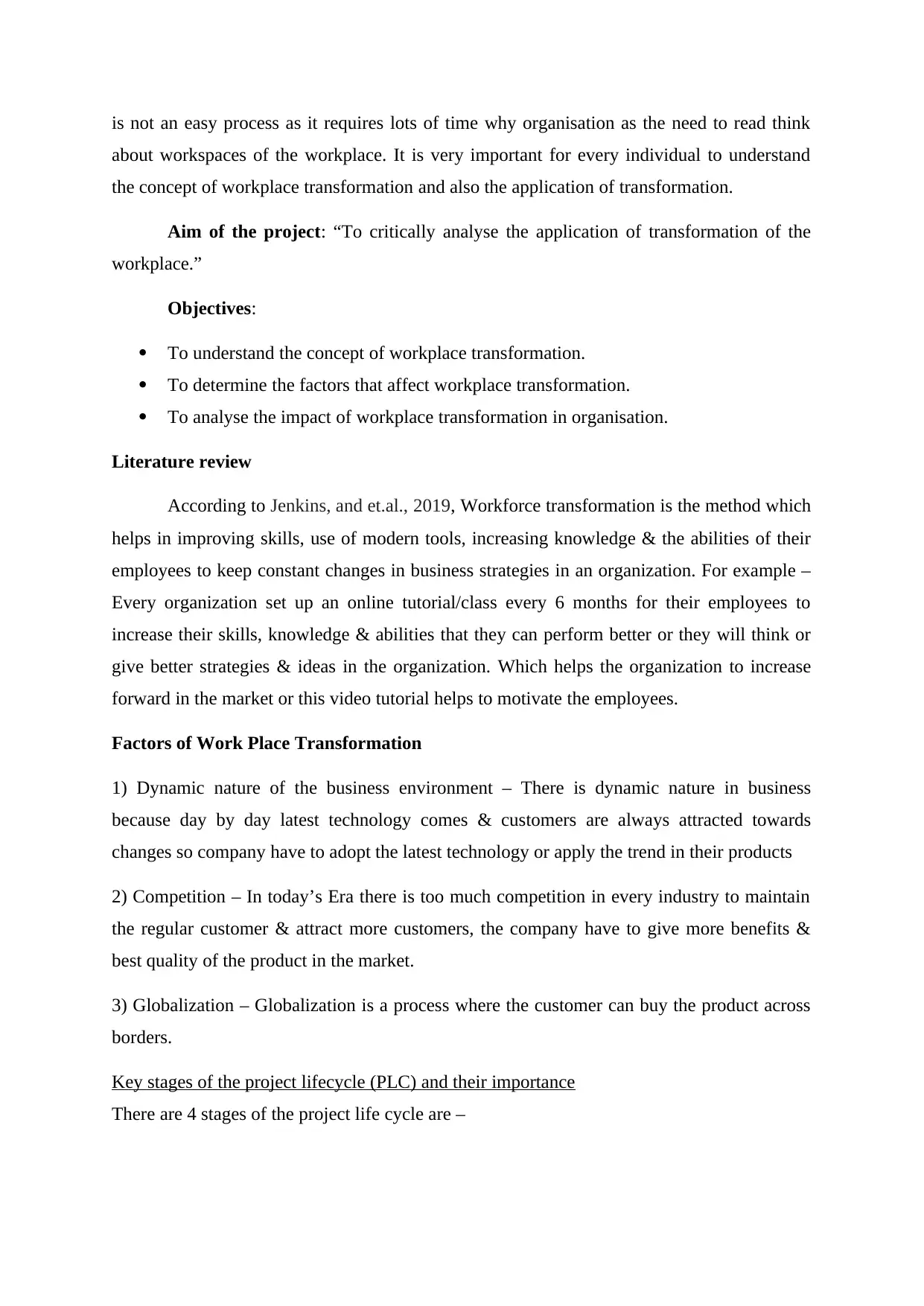
is not an easy process as it requires lots of time why organisation as the need to read think
about workspaces of the workplace. It is very important for every individual to understand
the concept of workplace transformation and also the application of transformation.
Aim of the project: “To critically analyse the application of transformation of the
workplace.”
Objectives:
To understand the concept of workplace transformation.
To determine the factors that affect workplace transformation.
To analyse the impact of workplace transformation in organisation.
Literature review
According to Jenkins, and et.al., 2019, Workforce transformation is the method which
helps in improving skills, use of modern tools, increasing knowledge & the abilities of their
employees to keep constant changes in business strategies in an organization. For example –
Every organization set up an online tutorial/class every 6 months for their employees to
increase their skills, knowledge & abilities that they can perform better or they will think or
give better strategies & ideas in the organization. Which helps the organization to increase
forward in the market or this video tutorial helps to motivate the employees.
Factors of Work Place Transformation
1) Dynamic nature of the business environment – There is dynamic nature in business
because day by day latest technology comes & customers are always attracted towards
changes so company have to adopt the latest technology or apply the trend in their products
2) Competition – In today’s Era there is too much competition in every industry to maintain
the regular customer & attract more customers, the company have to give more benefits &
best quality of the product in the market.
3) Globalization – Globalization is a process where the customer can buy the product across
borders.
Key stages of the project lifecycle (PLC) and their importance
There are 4 stages of the project life cycle are –
about workspaces of the workplace. It is very important for every individual to understand
the concept of workplace transformation and also the application of transformation.
Aim of the project: “To critically analyse the application of transformation of the
workplace.”
Objectives:
To understand the concept of workplace transformation.
To determine the factors that affect workplace transformation.
To analyse the impact of workplace transformation in organisation.
Literature review
According to Jenkins, and et.al., 2019, Workforce transformation is the method which
helps in improving skills, use of modern tools, increasing knowledge & the abilities of their
employees to keep constant changes in business strategies in an organization. For example –
Every organization set up an online tutorial/class every 6 months for their employees to
increase their skills, knowledge & abilities that they can perform better or they will think or
give better strategies & ideas in the organization. Which helps the organization to increase
forward in the market or this video tutorial helps to motivate the employees.
Factors of Work Place Transformation
1) Dynamic nature of the business environment – There is dynamic nature in business
because day by day latest technology comes & customers are always attracted towards
changes so company have to adopt the latest technology or apply the trend in their products
2) Competition – In today’s Era there is too much competition in every industry to maintain
the regular customer & attract more customers, the company have to give more benefits &
best quality of the product in the market.
3) Globalization – Globalization is a process where the customer can buy the product across
borders.
Key stages of the project lifecycle (PLC) and their importance
There are 4 stages of the project life cycle are –
Paraphrase This Document
Need a fresh take? Get an instant paraphrase of this document with our AI Paraphraser
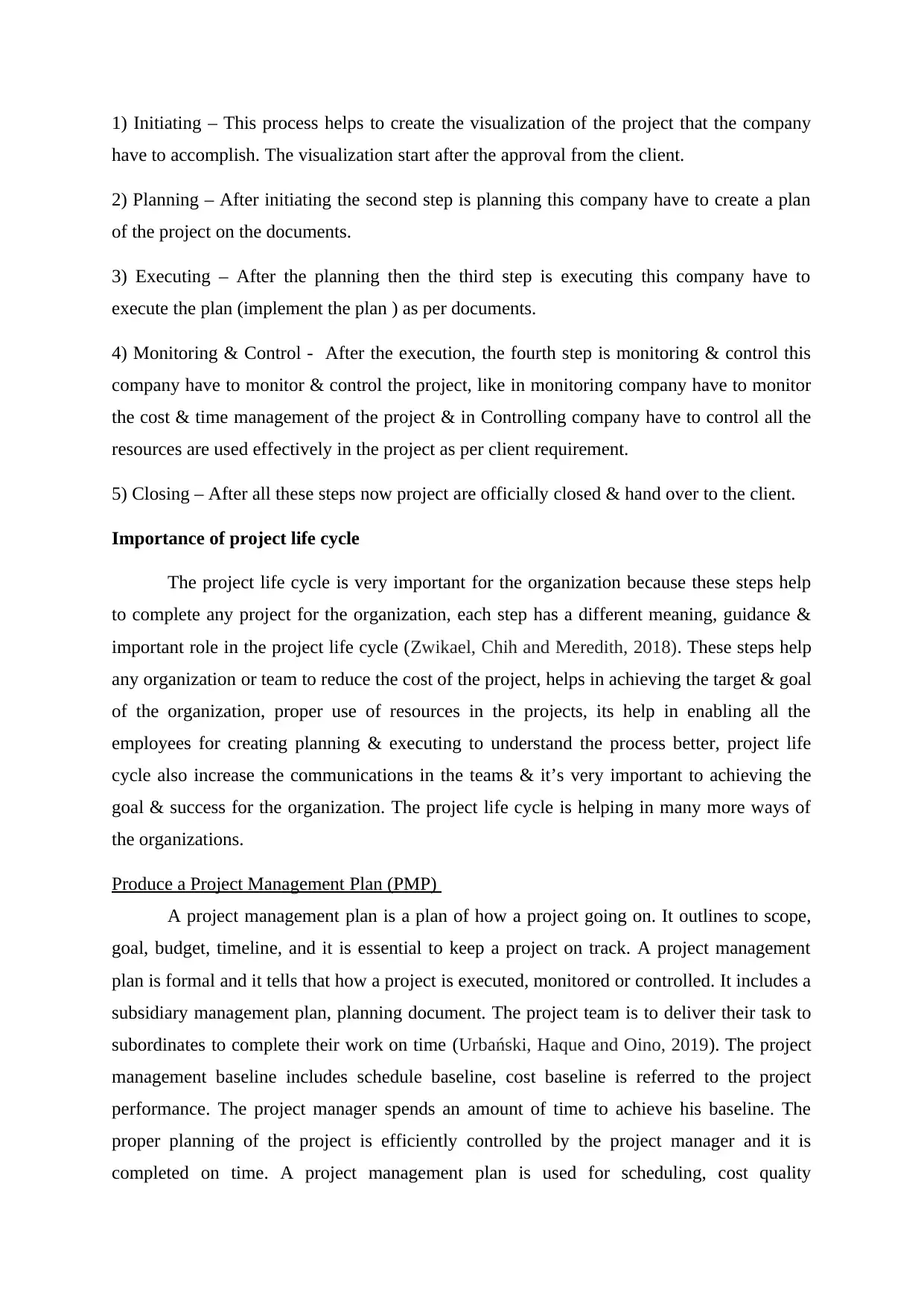
1) Initiating – This process helps to create the visualization of the project that the company
have to accomplish. The visualization start after the approval from the client.
2) Planning – After initiating the second step is planning this company have to create a plan
of the project on the documents.
3) Executing – After the planning then the third step is executing this company have to
execute the plan (implement the plan ) as per documents.
4) Monitoring & Control - After the execution, the fourth step is monitoring & control this
company have to monitor & control the project, like in monitoring company have to monitor
the cost & time management of the project & in Controlling company have to control all the
resources are used effectively in the project as per client requirement.
5) Closing – After all these steps now project are officially closed & hand over to the client.
Importance of project life cycle
The project life cycle is very important for the organization because these steps help
to complete any project for the organization, each step has a different meaning, guidance &
important role in the project life cycle (Zwikael, Chih and Meredith, 2018). These steps help
any organization or team to reduce the cost of the project, helps in achieving the target & goal
of the organization, proper use of resources in the projects, its help in enabling all the
employees for creating planning & executing to understand the process better, project life
cycle also increase the communications in the teams & it’s very important to achieving the
goal & success for the organization. The project life cycle is helping in many more ways of
the organizations.
Produce a Project Management Plan (PMP)
A project management plan is a plan of how a project going on. It outlines to scope,
goal, budget, timeline, and it is essential to keep a project on track. A project management
plan is formal and it tells that how a project is executed, monitored or controlled. It includes a
subsidiary management plan, planning document. The project team is to deliver their task to
subordinates to complete their work on time (Urbański, Haque and Oino, 2019). The project
management baseline includes schedule baseline, cost baseline is referred to the project
performance. The project manager spends an amount of time to achieve his baseline. The
proper planning of the project is efficiently controlled by the project manager and it is
completed on time. A project management plan is used for scheduling, cost quality
have to accomplish. The visualization start after the approval from the client.
2) Planning – After initiating the second step is planning this company have to create a plan
of the project on the documents.
3) Executing – After the planning then the third step is executing this company have to
execute the plan (implement the plan ) as per documents.
4) Monitoring & Control - After the execution, the fourth step is monitoring & control this
company have to monitor & control the project, like in monitoring company have to monitor
the cost & time management of the project & in Controlling company have to control all the
resources are used effectively in the project as per client requirement.
5) Closing – After all these steps now project are officially closed & hand over to the client.
Importance of project life cycle
The project life cycle is very important for the organization because these steps help
to complete any project for the organization, each step has a different meaning, guidance &
important role in the project life cycle (Zwikael, Chih and Meredith, 2018). These steps help
any organization or team to reduce the cost of the project, helps in achieving the target & goal
of the organization, proper use of resources in the projects, its help in enabling all the
employees for creating planning & executing to understand the process better, project life
cycle also increase the communications in the teams & it’s very important to achieving the
goal & success for the organization. The project life cycle is helping in many more ways of
the organizations.
Produce a Project Management Plan (PMP)
A project management plan is a plan of how a project going on. It outlines to scope,
goal, budget, timeline, and it is essential to keep a project on track. A project management
plan is formal and it tells that how a project is executed, monitored or controlled. It includes a
subsidiary management plan, planning document. The project team is to deliver their task to
subordinates to complete their work on time (Urbański, Haque and Oino, 2019). The project
management baseline includes schedule baseline, cost baseline is referred to the project
performance. The project manager spends an amount of time to achieve his baseline. The
proper planning of the project is efficiently controlled by the project manager and it is
completed on time. A project management plan is used for scheduling, cost quality
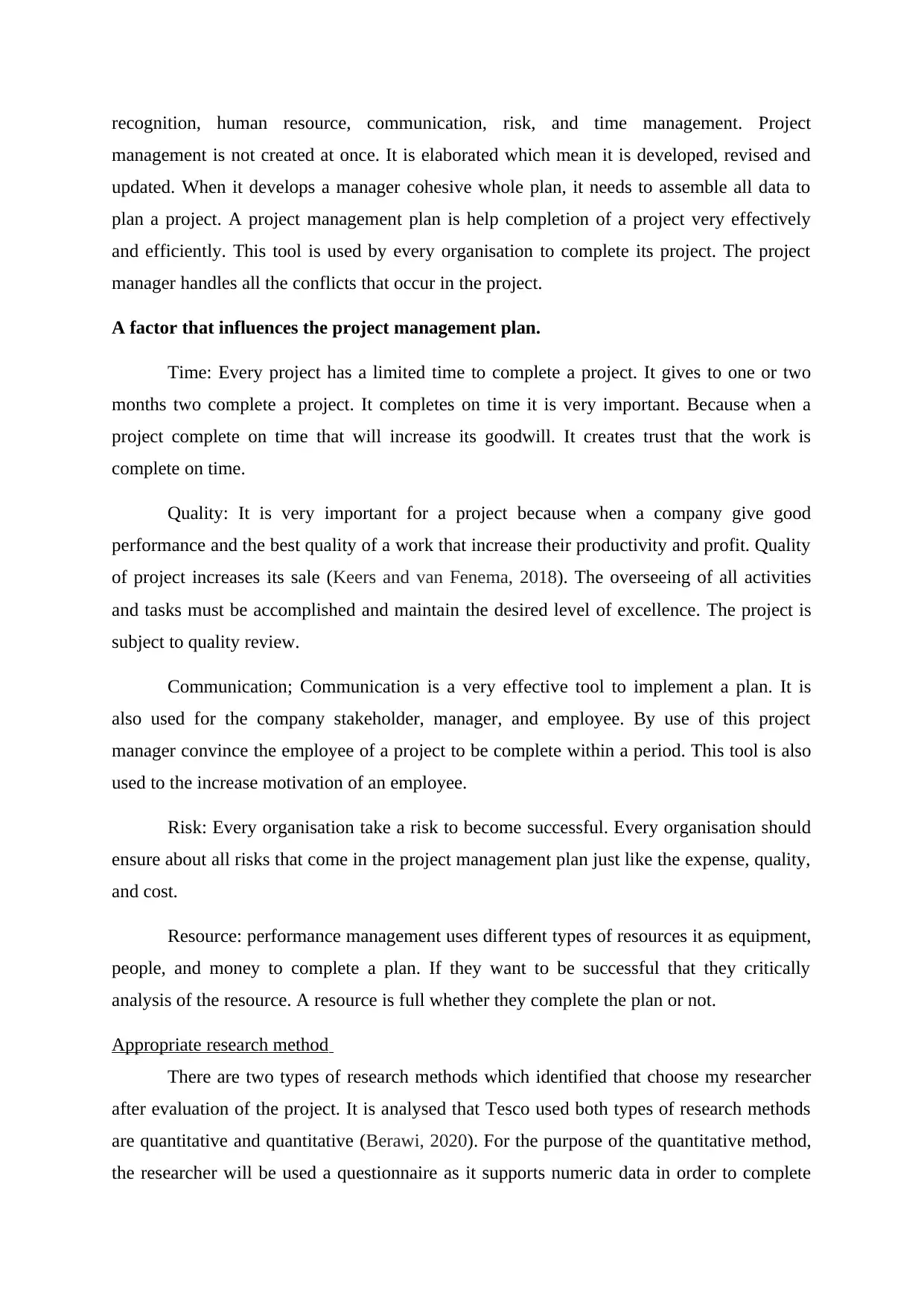
recognition, human resource, communication, risk, and time management. Project
management is not created at once. It is elaborated which mean it is developed, revised and
updated. When it develops a manager cohesive whole plan, it needs to assemble all data to
plan a project. A project management plan is help completion of a project very effectively
and efficiently. This tool is used by every organisation to complete its project. The project
manager handles all the conflicts that occur in the project.
A factor that influences the project management plan.
Time: Every project has a limited time to complete a project. It gives to one or two
months two complete a project. It completes on time it is very important. Because when a
project complete on time that will increase its goodwill. It creates trust that the work is
complete on time.
Quality: It is very important for a project because when a company give good
performance and the best quality of a work that increase their productivity and profit. Quality
of project increases its sale (Keers and van Fenema, 2018). The overseeing of all activities
and tasks must be accomplished and maintain the desired level of excellence. The project is
subject to quality review.
Communication; Communication is a very effective tool to implement a plan. It is
also used for the company stakeholder, manager, and employee. By use of this project
manager convince the employee of a project to be complete within a period. This tool is also
used to the increase motivation of an employee.
Risk: Every organisation take a risk to become successful. Every organisation should
ensure about all risks that come in the project management plan just like the expense, quality,
and cost.
Resource: performance management uses different types of resources it as equipment,
people, and money to complete a plan. If they want to be successful that they critically
analysis of the resource. A resource is full whether they complete the plan or not.
Appropriate research method
There are two types of research methods which identified that choose my researcher
after evaluation of the project. It is analysed that Tesco used both types of research methods
are quantitative and quantitative (Berawi, 2020). For the purpose of the quantitative method,
the researcher will be used a questionnaire as it supports numeric data in order to complete
management is not created at once. It is elaborated which mean it is developed, revised and
updated. When it develops a manager cohesive whole plan, it needs to assemble all data to
plan a project. A project management plan is help completion of a project very effectively
and efficiently. This tool is used by every organisation to complete its project. The project
manager handles all the conflicts that occur in the project.
A factor that influences the project management plan.
Time: Every project has a limited time to complete a project. It gives to one or two
months two complete a project. It completes on time it is very important. Because when a
project complete on time that will increase its goodwill. It creates trust that the work is
complete on time.
Quality: It is very important for a project because when a company give good
performance and the best quality of a work that increase their productivity and profit. Quality
of project increases its sale (Keers and van Fenema, 2018). The overseeing of all activities
and tasks must be accomplished and maintain the desired level of excellence. The project is
subject to quality review.
Communication; Communication is a very effective tool to implement a plan. It is
also used for the company stakeholder, manager, and employee. By use of this project
manager convince the employee of a project to be complete within a period. This tool is also
used to the increase motivation of an employee.
Risk: Every organisation take a risk to become successful. Every organisation should
ensure about all risks that come in the project management plan just like the expense, quality,
and cost.
Resource: performance management uses different types of resources it as equipment,
people, and money to complete a plan. If they want to be successful that they critically
analysis of the resource. A resource is full whether they complete the plan or not.
Appropriate research method
There are two types of research methods which identified that choose my researcher
after evaluation of the project. It is analysed that Tesco used both types of research methods
are quantitative and quantitative (Berawi, 2020). For the purpose of the quantitative method,
the researcher will be used a questionnaire as it supports numeric data in order to complete
⊘ This is a preview!⊘
Do you want full access?
Subscribe today to unlock all pages.

Trusted by 1+ million students worldwide
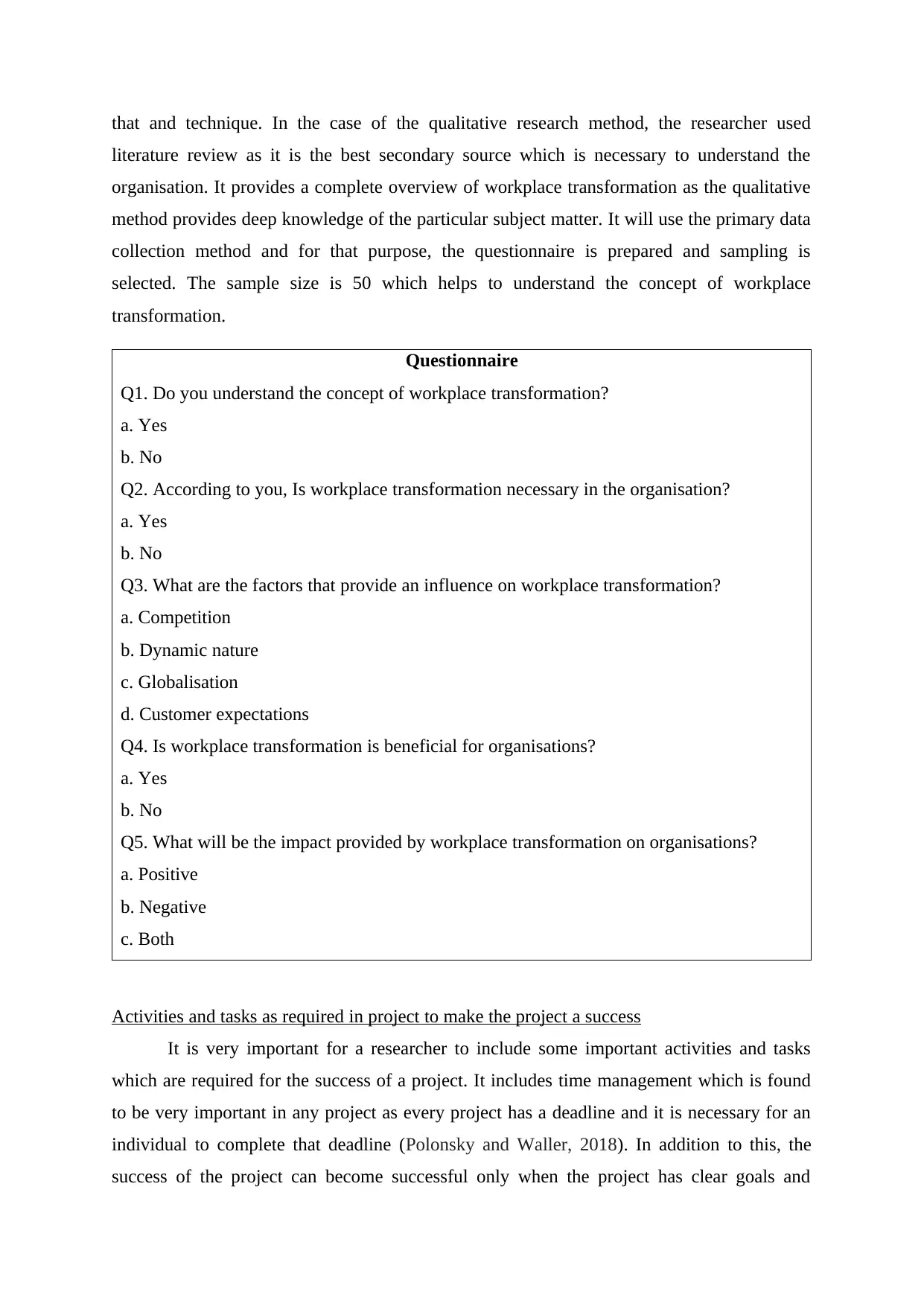
that and technique. In the case of the qualitative research method, the researcher used
literature review as it is the best secondary source which is necessary to understand the
organisation. It provides a complete overview of workplace transformation as the qualitative
method provides deep knowledge of the particular subject matter. It will use the primary data
collection method and for that purpose, the questionnaire is prepared and sampling is
selected. The sample size is 50 which helps to understand the concept of workplace
transformation.
Questionnaire
Q1. Do you understand the concept of workplace transformation?
a. Yes
b. No
Q2. According to you, Is workplace transformation necessary in the organisation?
a. Yes
b. No
Q3. What are the factors that provide an influence on workplace transformation?
a. Competition
b. Dynamic nature
c. Globalisation
d. Customer expectations
Q4. Is workplace transformation is beneficial for organisations?
a. Yes
b. No
Q5. What will be the impact provided by workplace transformation on organisations?
a. Positive
b. Negative
c. Both
Activities and tasks as required in project to make the project a success
It is very important for a researcher to include some important activities and tasks
which are required for the success of a project. It includes time management which is found
to be very important in any project as every project has a deadline and it is necessary for an
individual to complete that deadline (Polonsky and Waller, 2018). In addition to this, the
success of the project can become successful only when the project has clear goals and
literature review as it is the best secondary source which is necessary to understand the
organisation. It provides a complete overview of workplace transformation as the qualitative
method provides deep knowledge of the particular subject matter. It will use the primary data
collection method and for that purpose, the questionnaire is prepared and sampling is
selected. The sample size is 50 which helps to understand the concept of workplace
transformation.
Questionnaire
Q1. Do you understand the concept of workplace transformation?
a. Yes
b. No
Q2. According to you, Is workplace transformation necessary in the organisation?
a. Yes
b. No
Q3. What are the factors that provide an influence on workplace transformation?
a. Competition
b. Dynamic nature
c. Globalisation
d. Customer expectations
Q4. Is workplace transformation is beneficial for organisations?
a. Yes
b. No
Q5. What will be the impact provided by workplace transformation on organisations?
a. Positive
b. Negative
c. Both
Activities and tasks as required in project to make the project a success
It is very important for a researcher to include some important activities and tasks
which are required for the success of a project. It includes time management which is found
to be very important in any project as every project has a deadline and it is necessary for an
individual to complete that deadline (Polonsky and Waller, 2018). In addition to this, the
success of the project can become successful only when the project has clear goals and
Paraphrase This Document
Need a fresh take? Get an instant paraphrase of this document with our AI Paraphraser
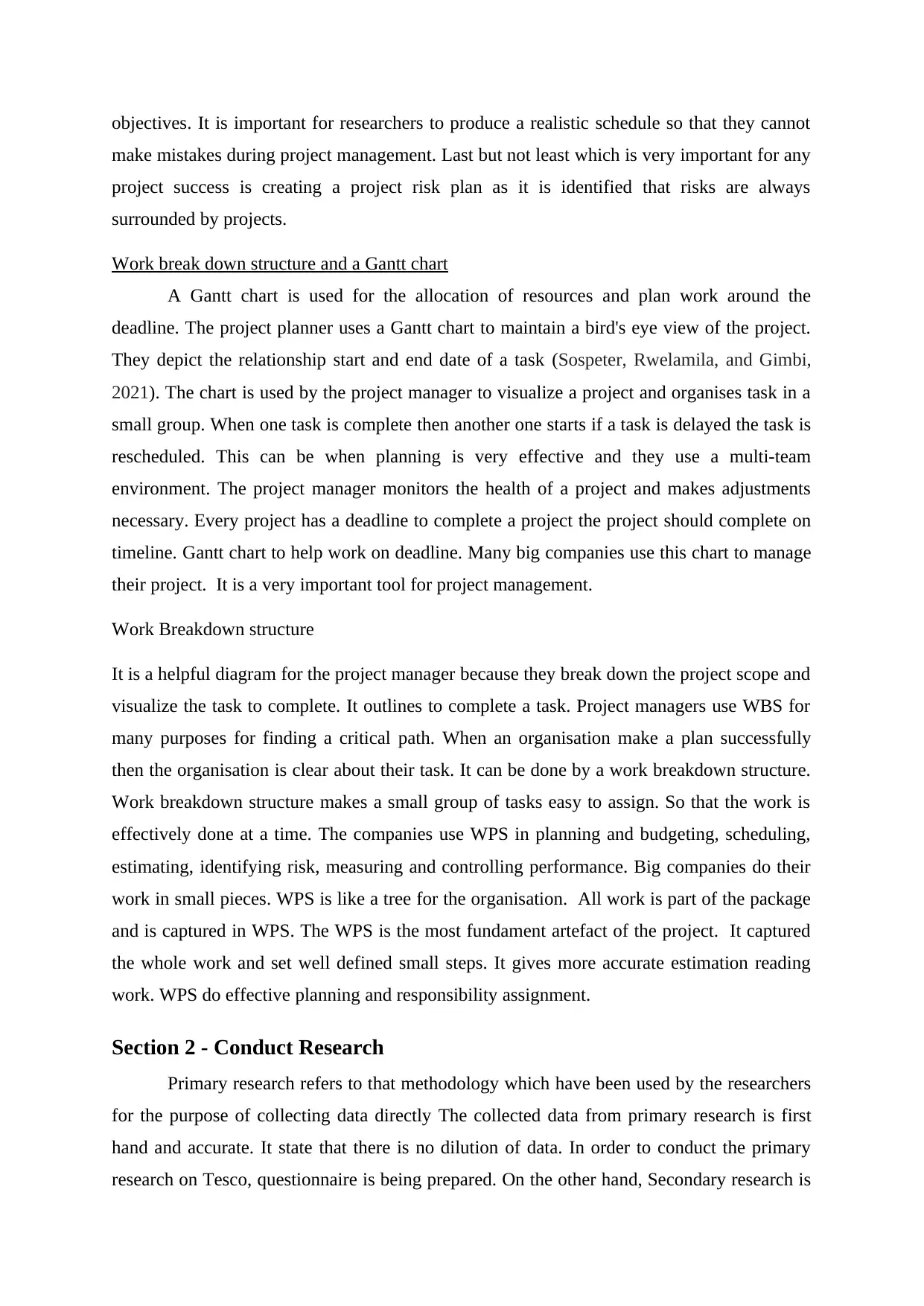
objectives. It is important for researchers to produce a realistic schedule so that they cannot
make mistakes during project management. Last but not least which is very important for any
project success is creating a project risk plan as it is identified that risks are always
surrounded by projects.
Work break down structure and a Gantt chart
A Gantt chart is used for the allocation of resources and plan work around the
deadline. The project planner uses a Gantt chart to maintain a bird's eye view of the project.
They depict the relationship start and end date of a task (Sospeter, Rwelamila, and Gimbi,
2021). The chart is used by the project manager to visualize a project and organises task in a
small group. When one task is complete then another one starts if a task is delayed the task is
rescheduled. This can be when planning is very effective and they use a multi-team
environment. The project manager monitors the health of a project and makes adjustments
necessary. Every project has a deadline to complete a project the project should complete on
timeline. Gantt chart to help work on deadline. Many big companies use this chart to manage
their project. It is a very important tool for project management.
Work Breakdown structure
It is a helpful diagram for the project manager because they break down the project scope and
visualize the task to complete. It outlines to complete a task. Project managers use WBS for
many purposes for finding a critical path. When an organisation make a plan successfully
then the organisation is clear about their task. It can be done by a work breakdown structure.
Work breakdown structure makes a small group of tasks easy to assign. So that the work is
effectively done at a time. The companies use WPS in planning and budgeting, scheduling,
estimating, identifying risk, measuring and controlling performance. Big companies do their
work in small pieces. WPS is like a tree for the organisation. All work is part of the package
and is captured in WPS. The WPS is the most fundament artefact of the project. It captured
the whole work and set well defined small steps. It gives more accurate estimation reading
work. WPS do effective planning and responsibility assignment.
Section 2 - Conduct Research
Primary research refers to that methodology which have been used by the researchers
for the purpose of collecting data directly The collected data from primary research is first
hand and accurate. It state that there is no dilution of data. In order to conduct the primary
research on Tesco, questionnaire is being prepared. On the other hand, Secondary research is
make mistakes during project management. Last but not least which is very important for any
project success is creating a project risk plan as it is identified that risks are always
surrounded by projects.
Work break down structure and a Gantt chart
A Gantt chart is used for the allocation of resources and plan work around the
deadline. The project planner uses a Gantt chart to maintain a bird's eye view of the project.
They depict the relationship start and end date of a task (Sospeter, Rwelamila, and Gimbi,
2021). The chart is used by the project manager to visualize a project and organises task in a
small group. When one task is complete then another one starts if a task is delayed the task is
rescheduled. This can be when planning is very effective and they use a multi-team
environment. The project manager monitors the health of a project and makes adjustments
necessary. Every project has a deadline to complete a project the project should complete on
timeline. Gantt chart to help work on deadline. Many big companies use this chart to manage
their project. It is a very important tool for project management.
Work Breakdown structure
It is a helpful diagram for the project manager because they break down the project scope and
visualize the task to complete. It outlines to complete a task. Project managers use WBS for
many purposes for finding a critical path. When an organisation make a plan successfully
then the organisation is clear about their task. It can be done by a work breakdown structure.
Work breakdown structure makes a small group of tasks easy to assign. So that the work is
effectively done at a time. The companies use WPS in planning and budgeting, scheduling,
estimating, identifying risk, measuring and controlling performance. Big companies do their
work in small pieces. WPS is like a tree for the organisation. All work is part of the package
and is captured in WPS. The WPS is the most fundament artefact of the project. It captured
the whole work and set well defined small steps. It gives more accurate estimation reading
work. WPS do effective planning and responsibility assignment.
Section 2 - Conduct Research
Primary research refers to that methodology which have been used by the researchers
for the purpose of collecting data directly The collected data from primary research is first
hand and accurate. It state that there is no dilution of data. In order to conduct the primary
research on Tesco, questionnaire is being prepared. On the other hand, Secondary research is
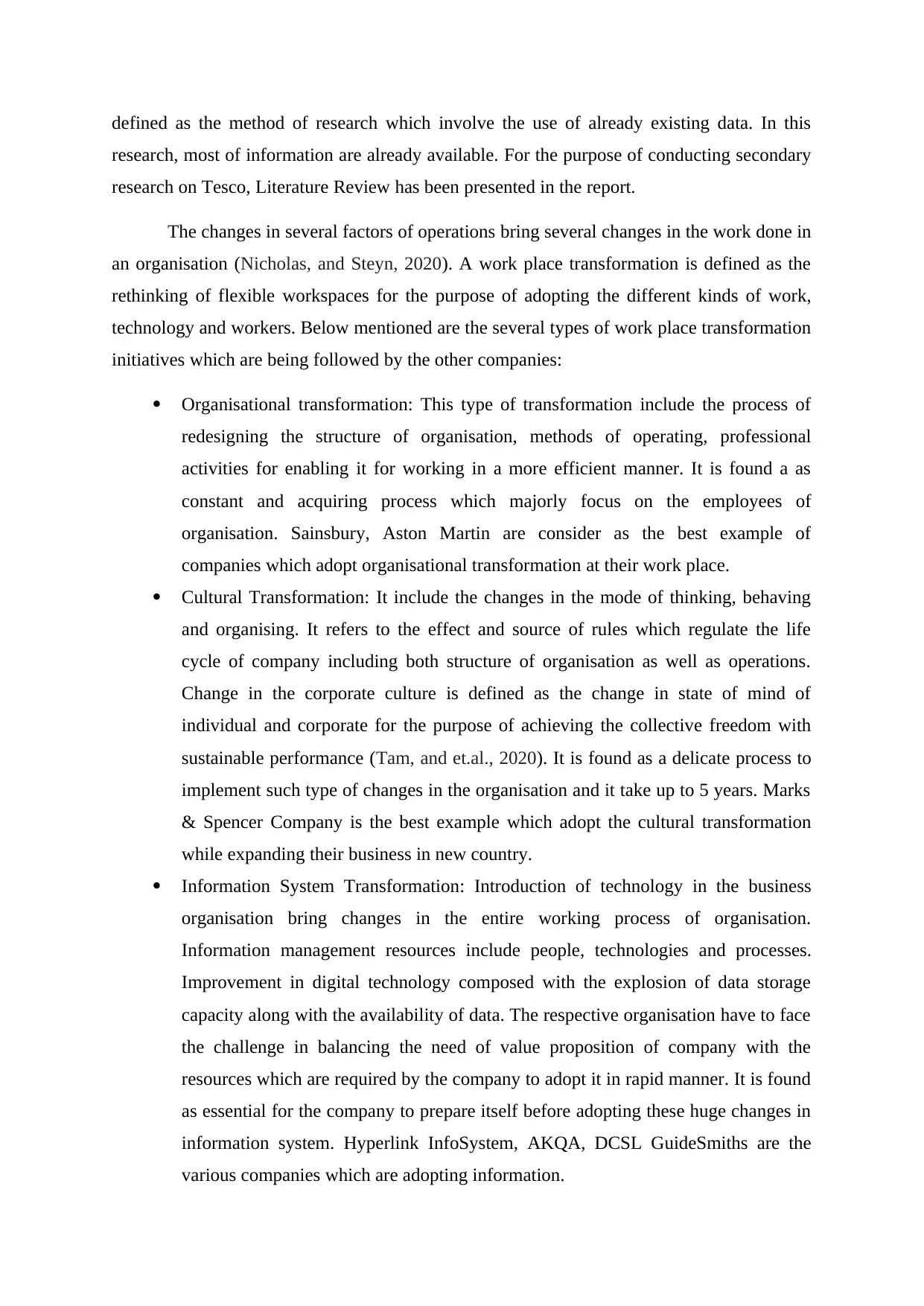
defined as the method of research which involve the use of already existing data. In this
research, most of information are already available. For the purpose of conducting secondary
research on Tesco, Literature Review has been presented in the report.
The changes in several factors of operations bring several changes in the work done in
an organisation (Nicholas, and Steyn, 2020). A work place transformation is defined as the
rethinking of flexible workspaces for the purpose of adopting the different kinds of work,
technology and workers. Below mentioned are the several types of work place transformation
initiatives which are being followed by the other companies:
Organisational transformation: This type of transformation include the process of
redesigning the structure of organisation, methods of operating, professional
activities for enabling it for working in a more efficient manner. It is found a as
constant and acquiring process which majorly focus on the employees of
organisation. Sainsbury, Aston Martin are consider as the best example of
companies which adopt organisational transformation at their work place.
Cultural Transformation: It include the changes in the mode of thinking, behaving
and organising. It refers to the effect and source of rules which regulate the life
cycle of company including both structure of organisation as well as operations.
Change in the corporate culture is defined as the change in state of mind of
individual and corporate for the purpose of achieving the collective freedom with
sustainable performance (Tam, and et.al., 2020). It is found as a delicate process to
implement such type of changes in the organisation and it take up to 5 years. Marks
& Spencer Company is the best example which adopt the cultural transformation
while expanding their business in new country.
Information System Transformation: Introduction of technology in the business
organisation bring changes in the entire working process of organisation.
Information management resources include people, technologies and processes.
Improvement in digital technology composed with the explosion of data storage
capacity along with the availability of data. The respective organisation have to face
the challenge in balancing the need of value proposition of company with the
resources which are required by the company to adopt it in rapid manner. It is found
as essential for the company to prepare itself before adopting these huge changes in
information system. Hyperlink InfoSystem, AKQA, DCSL GuideSmiths are the
various companies which are adopting information.
research, most of information are already available. For the purpose of conducting secondary
research on Tesco, Literature Review has been presented in the report.
The changes in several factors of operations bring several changes in the work done in
an organisation (Nicholas, and Steyn, 2020). A work place transformation is defined as the
rethinking of flexible workspaces for the purpose of adopting the different kinds of work,
technology and workers. Below mentioned are the several types of work place transformation
initiatives which are being followed by the other companies:
Organisational transformation: This type of transformation include the process of
redesigning the structure of organisation, methods of operating, professional
activities for enabling it for working in a more efficient manner. It is found a as
constant and acquiring process which majorly focus on the employees of
organisation. Sainsbury, Aston Martin are consider as the best example of
companies which adopt organisational transformation at their work place.
Cultural Transformation: It include the changes in the mode of thinking, behaving
and organising. It refers to the effect and source of rules which regulate the life
cycle of company including both structure of organisation as well as operations.
Change in the corporate culture is defined as the change in state of mind of
individual and corporate for the purpose of achieving the collective freedom with
sustainable performance (Tam, and et.al., 2020). It is found as a delicate process to
implement such type of changes in the organisation and it take up to 5 years. Marks
& Spencer Company is the best example which adopt the cultural transformation
while expanding their business in new country.
Information System Transformation: Introduction of technology in the business
organisation bring changes in the entire working process of organisation.
Information management resources include people, technologies and processes.
Improvement in digital technology composed with the explosion of data storage
capacity along with the availability of data. The respective organisation have to face
the challenge in balancing the need of value proposition of company with the
resources which are required by the company to adopt it in rapid manner. It is found
as essential for the company to prepare itself before adopting these huge changes in
information system. Hyperlink InfoSystem, AKQA, DCSL GuideSmiths are the
various companies which are adopting information.
⊘ This is a preview!⊘
Do you want full access?
Subscribe today to unlock all pages.

Trusted by 1+ million students worldwide
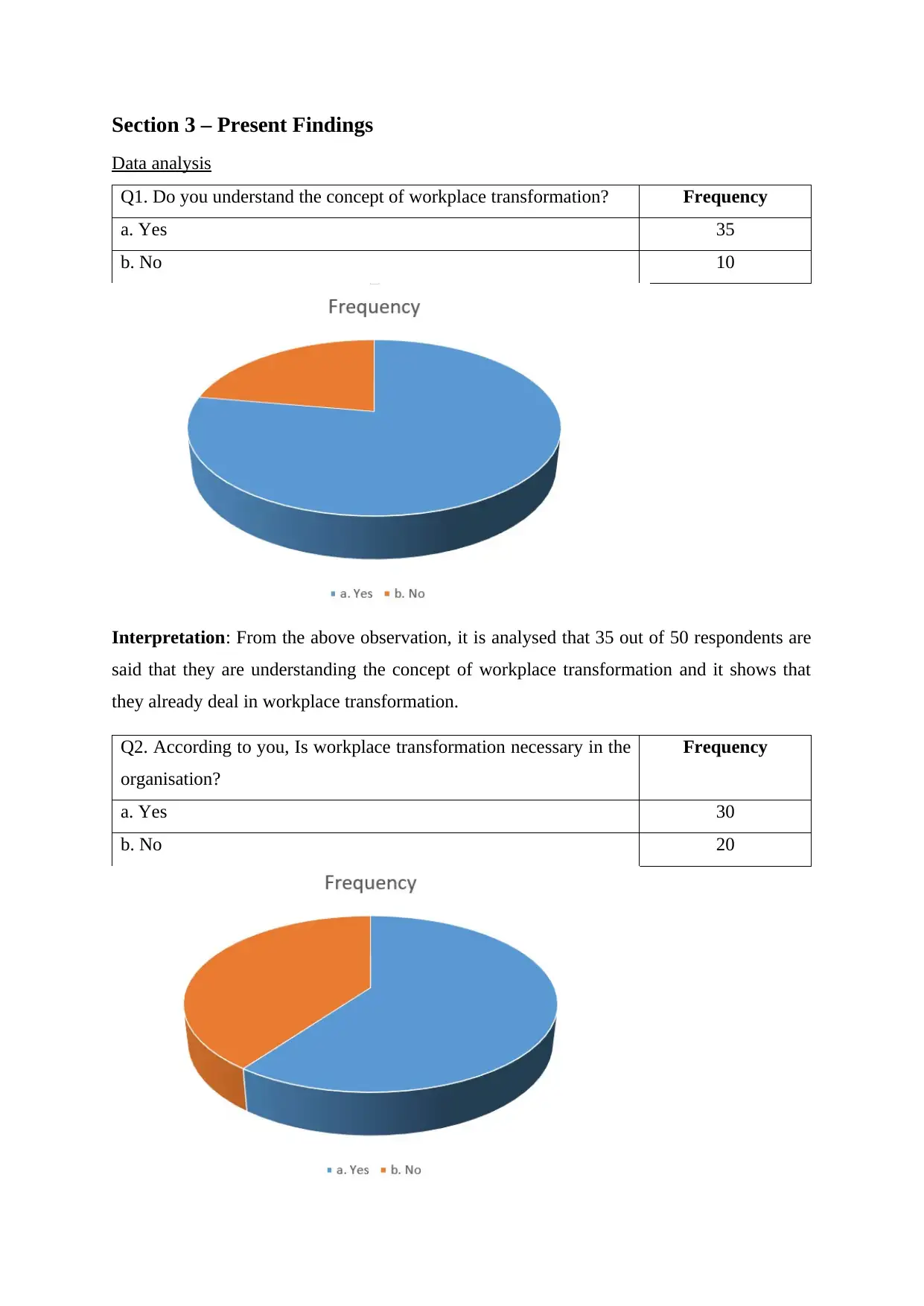
Section 3 – Present Findings
Data analysis
Q1. Do you understand the concept of workplace transformation? Frequency
a. Yes 35
b. No 10
Interpretation: From the above observation, it is analysed that 35 out of 50 respondents are
said that they are understanding the concept of workplace transformation and it shows that
they already deal in workplace transformation.
Q2. According to you, Is workplace transformation necessary in the
organisation?
Frequency
a. Yes 30
b. No 20
Data analysis
Q1. Do you understand the concept of workplace transformation? Frequency
a. Yes 35
b. No 10
Interpretation: From the above observation, it is analysed that 35 out of 50 respondents are
said that they are understanding the concept of workplace transformation and it shows that
they already deal in workplace transformation.
Q2. According to you, Is workplace transformation necessary in the
organisation?
Frequency
a. Yes 30
b. No 20
Paraphrase This Document
Need a fresh take? Get an instant paraphrase of this document with our AI Paraphraser

Interpretation: As per the above data, it is analysed that workplace transformation is
becoming very important and crucial in the organisation. This can be said with the help of
observation as 30 out of 50 respondents said yes.
Q3. What are the factors that provide an influence on workplace
transformation?
Frequency
a. Competition 10
b. Dynamic nature 15
c. Globalisation 15
d. Customer expectations 10
Interpretation: There are many factors that provide impacts on workplace transformation
and it is necessary for an organisation to understand so that they can make the right decision
at right time. From the above observation, it is analysed that competition, customer
expectation, dynamic nature of the business environment and globalisation are found to be
the most important factors which provided and influence workplace transformation.
Q4. Is workplace transformation is beneficial for organisations? Frequency
a. Yes 30
b. No 20
becoming very important and crucial in the organisation. This can be said with the help of
observation as 30 out of 50 respondents said yes.
Q3. What are the factors that provide an influence on workplace
transformation?
Frequency
a. Competition 10
b. Dynamic nature 15
c. Globalisation 15
d. Customer expectations 10
Interpretation: There are many factors that provide impacts on workplace transformation
and it is necessary for an organisation to understand so that they can make the right decision
at right time. From the above observation, it is analysed that competition, customer
expectation, dynamic nature of the business environment and globalisation are found to be
the most important factors which provided and influence workplace transformation.
Q4. Is workplace transformation is beneficial for organisations? Frequency
a. Yes 30
b. No 20
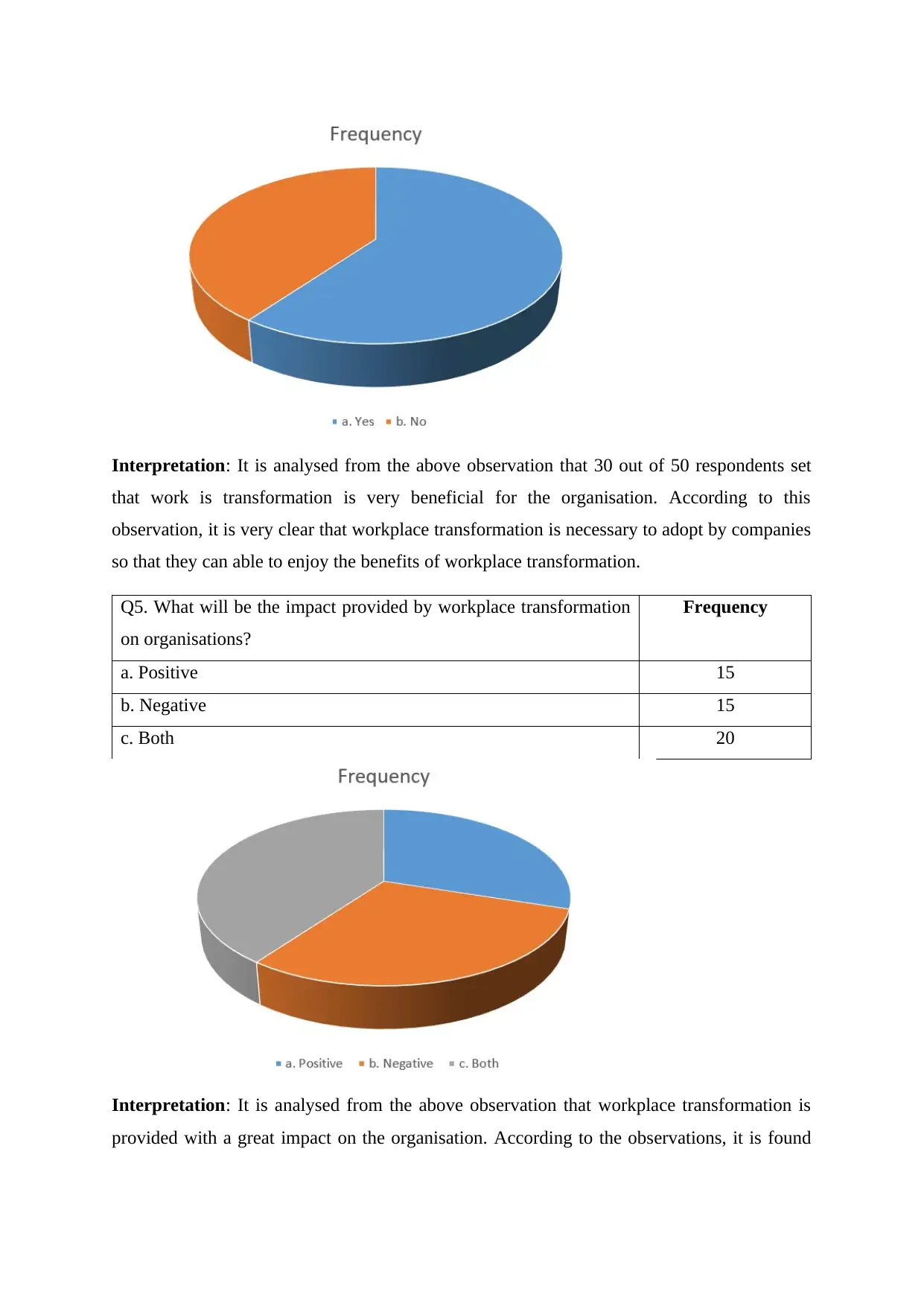
Interpretation: It is analysed from the above observation that 30 out of 50 respondents set
that work is transformation is very beneficial for the organisation. According to this
observation, it is very clear that workplace transformation is necessary to adopt by companies
so that they can able to enjoy the benefits of workplace transformation.
Q5. What will be the impact provided by workplace transformation
on organisations?
Frequency
a. Positive 15
b. Negative 15
c. Both 20
Interpretation: It is analysed from the above observation that workplace transformation is
provided with a great impact on the organisation. According to the observations, it is found
that work is transformation is very beneficial for the organisation. According to this
observation, it is very clear that workplace transformation is necessary to adopt by companies
so that they can able to enjoy the benefits of workplace transformation.
Q5. What will be the impact provided by workplace transformation
on organisations?
Frequency
a. Positive 15
b. Negative 15
c. Both 20
Interpretation: It is analysed from the above observation that workplace transformation is
provided with a great impact on the organisation. According to the observations, it is found
⊘ This is a preview!⊘
Do you want full access?
Subscribe today to unlock all pages.

Trusted by 1+ million students worldwide
1 out of 21
Related Documents
Your All-in-One AI-Powered Toolkit for Academic Success.
+13062052269
info@desklib.com
Available 24*7 on WhatsApp / Email
![[object Object]](/_next/static/media/star-bottom.7253800d.svg)
Unlock your academic potential
Copyright © 2020–2025 A2Z Services. All Rights Reserved. Developed and managed by ZUCOL.




